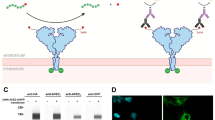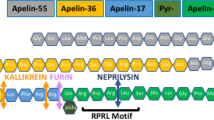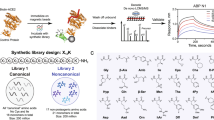Abstract
Angiotensin I-converting enzyme (ACE) assays are commonly used for measuring enzymatic activity in clinical and biological samples. The fluorimetric procedure described is sensitive, rapid and involves unsophisticated procedures and inexpensive reagents. It uses the substrate hippuryl-L-histidyl-L-leucine, and the fluorescent adduct of the enzyme-catalyzed product L-histidyl-L-leucine is quantified fluorimetrically. This assay has been adapted for a 96-well plate format that produces comparable data to previously described assays and has the advantage of greater efficiency with respect to both time and reagents. The protocol can be used for routine purposes or for more detailed kinetic analyses. The apparent Km and kcat values for purified testis ACE determined from a double reciprocal plot were 3.0 mM and 195.7 s−1, respectively. The protocol can be completed within 4 h.
This is a preview of subscription content, access via your institution
Access options
Subscribe to this journal
Receive 12 print issues and online access
$259.00 per year
only $21.58 per issue
Buy this article
- Purchase on Springer Link
- Instant access to full article PDF
Prices may be subject to local taxes which are calculated during checkout



Similar content being viewed by others
References
Costabel, U. & Teschler, H. Biochemical changes in sarcoidosis. Clin. Chest Med. 18, 827–842 (1997).
Baudin, B. New aspects on angiotensin-converting enzyme: from gene to disease. Clin. Chem. Lab. Med. 40, 256–265 (2002).
Skeggs, S.L.T. Jr, Kahn, J.R. & Shumway, N.P. The preparation and function of the hypertensin-converting enzyme. J. Exp. Med. 103, 295–299 (1956).
Helmer, O.M. Differentiation between two forms of angiotonin by means of spirally cut strips of rabbit aorta. Am. J. Physiol. 188, 571–577 (1957).
Mehanna, A.S. & Dowling, M. Liquid chromatographic determination of hippuric acid for the evaluation of ethacrynic acid as angiotensin converting enzyme inhibitor. J. Pharmaceut. Biomed. Anal. 19, 967–973 (1999).
Wu, J., Aluko, R.E. & Muir, A.D. Improved method for direct high-performance liquid chromatography assay of angiotensin-converting enzyme-catalyzed reactions. J. Chromatogr. A 950, 125–130 (2002).
Xiao, X., Luo, X., Chen, B. & Yao, S. Determination of angiotensin converting enzyme inhibitory activity by high-performance liquid chromatography/electrospray-mass spectrometry. J. Chromatogr. B Anal. Technol. Biomed. Life Sci. 834, 48–54 (2006).
Cushman, D.W. & Cheung, H.S. Spectrophotometric assay and properties of the angiotensin-converting enzyme of rabbit lung. Biochem. Pharmacol. 20, 1637–1648 (1971).
Soffer, R.L. Angiotensin-converting enzyme and the regulation of vasoactive peptides. Annu. Rev. Biochem. 45, 73–94 (1976).
Piquilloud, Y., Reinharz, A. & Roth, M. Action of converting enzyme on synthetic substrates. Helv. Physiol. Pharmacol. Acta 26, CR-2 (1968).
Piquilloud, Y., Reinharz, A. & Roth, M. Studies on the angiotensin converting enzyme with different substrates. Biochim. Biophys. Acta 206, 136–142 (1970).
Friedland, J. & Silverstein, E. A sensitive fluorimetric assay for serum angiotensin-converting enzyme. Am. J. Clin. Pathol. 66, 416–424 (1976).
Bunning, P. & Riordan, J.F. Activation of angiotensin converting enzyme by monovalent anions. Biochemistry 22, 110–116 (1983).
Wei, L., Clauser, E., Alhenc-Gelas, F. & Corvol, P. The two homologous domains of human angiotensin I-converting enzyme interact differently with competitive inhibitors. J. Biol. Chem. 267, 13398–13405 (1992).
Acknowledgements
This work was supported by the South African National Research Foundation, the Wellcome Trust (UK) grant 070060.
Author information
Authors and Affiliations
Corresponding author
Ethics declarations
Competing interests
The authors declare no competing financial interests.
Rights and permissions
About this article
Cite this article
Schwager, S., Carmona, A. & Sturrock, E. A high-throughput fluorimetric assay for angiotensin I-converting enzyme. Nat Protoc 1, 1961–1964 (2006). https://doi.org/10.1038/nprot.2006.305
Published:
Issue Date:
DOI: https://doi.org/10.1038/nprot.2006.305
This article is cited by
-
Newly manufactured Marukome MK-34-1 miso with angiotensin-converting enzyme inhibitory activity and its antihypertensive effects in genetic hypertensive rat models
Hypertension Research (2019)
-
Structural basis of Ac-SDKP hydrolysis by Angiotensin-I converting enzyme
Scientific Reports (2015)
-
Antioxidant and Anti-hypertensive Activity, and Cytotoxicity of Amino Acids-Enriched Salt Recovered from Codfish (Gadus morhua L.) Salting Wastewater
Waste and Biomass Valorization (2015)
-
Bioactivity comparison of extracts from various parts of common and tartary buckwheats: evaluation of the antioxidant- and angiotensin-converting enzyme inhibitory activities
Chemistry Central Journal (2012)
Comments
By submitting a comment you agree to abide by our Terms and Community Guidelines. If you find something abusive or that does not comply with our terms or guidelines please flag it as inappropriate.



